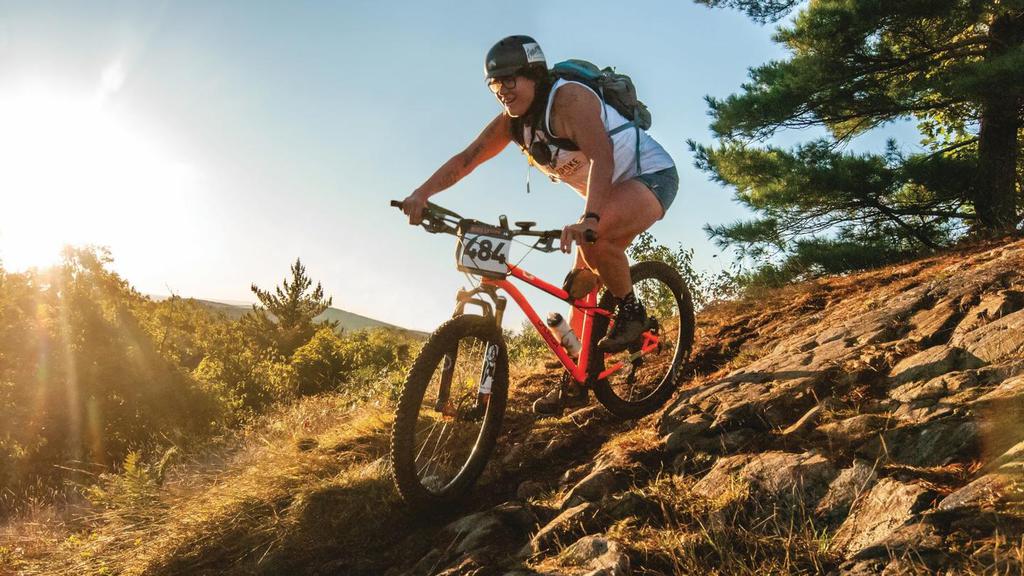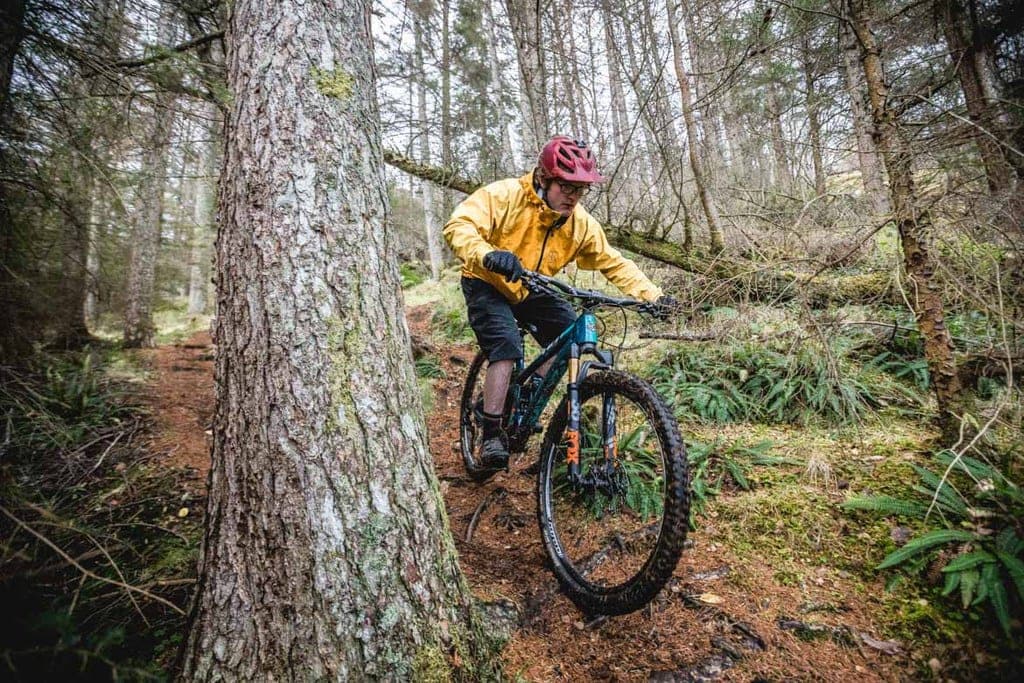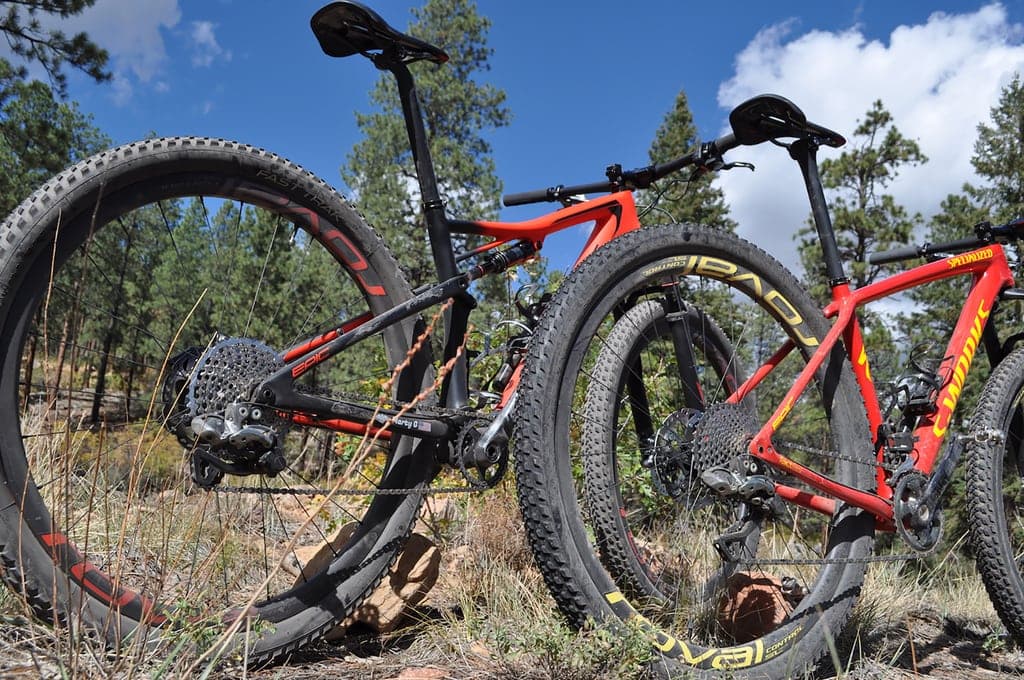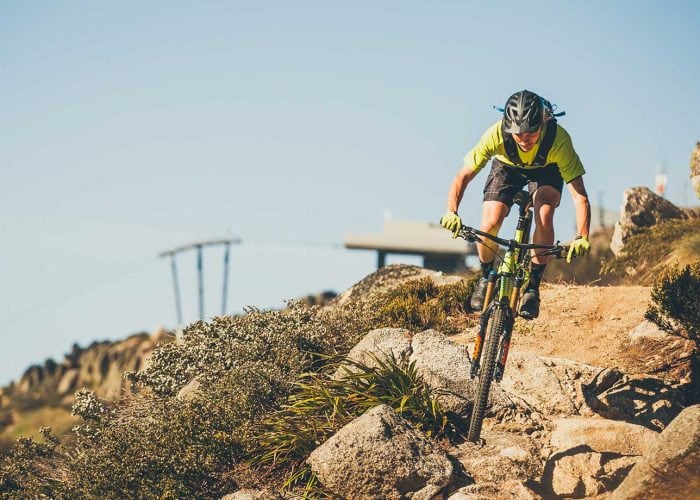The 8 Best Mountain Bike Tires in 2020
You’ve probably worn down those stock tires on your mountain bike, or maybe you want to upgrade to one that’s going to give you better performance.
The problem is, picking up a set of new tires is more complicated than you thought. There are a lot more variants that suit different types of riding surfaces as compared to a road tire.
Things like,
- How wide should the tire be?
- What is the ideal compound?
- Which thread pattern for your type of riding?
…and many more questions.
I’ll discuss them in detail below and also give a shout-out to some of the popular mountain bike tires in the market today.
A Quick Glance : Our Favorite Tires for Mountain Biking
All-rounder MTB Tires
Schwalbe Nobby Nic

Schwalbe says it designed the Nobby Nic Addix to fit the widest possible range of use.
This aptly named tire from Schwalbe certainly is nobby, but that doesn’t mean it’s a slow tire either. As such, the Addix features strategically arranged lugs that provide a mix of good roll and traction.
Central studs are spaced such that they provide solid tracking over off-road terrain while still maintaining good roll while wide channels and gaps facilitate excellent mud-shedding.
The sides, meanwhile, feature taller for winding singletrack. With its versatile tread pattern and 2.35” width, the tubeless Addix is indeed a great option for a cross-country adventure or technical singletrack.
- Pros : Versatile with good traction on dry and wet terrains.
- Cons : Expensive.
Maxxis Ardent

The Maxxis Ardent tires offer a nice combination of speed and grip.
With its versatile tread pattern and 2.25″ wide profile, the Maxxis Ardent is a great option for cross-country biking and trail riding.
The ramped center lugs provide solid roll for this tire while the nobby sides bite into the dirt for cornering. The Ardent also has wide channels between its center tread and side treads for excellent mud shedding.
There are also tires that are tubeless-ready and dual-compound rubber for added durability, traction, and speed. It also features an EXO casing for extra protection from punctures.
- Pros : Lower rolling resistance compared to other similar tires.
- Cons : Heavy for a 2.25″ wide tire.
XC MTB Tires
Maxxis Ikon+
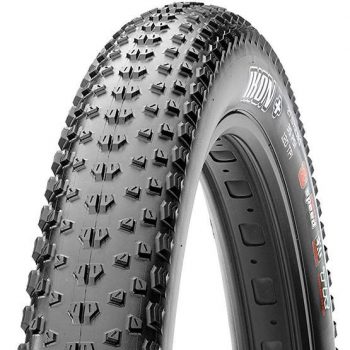
The Maxxis Ikon+ is built for off-road speed.
That much is apparent by its high TPI value, which stands for thread per inch. Tires with high TPI tend to be thinner and lighter with a low roll resistance. Most mountain bike tires typically have a TPI of around 60. The Ikon+ has a TPI of 120, which is typical of thinner racing tires.
But that’s not to say it’s prone to flats. Maxxis reinforces the thinner Ikon with its EXO casing to prevent punctures. Despite its smaller nobs, the Maxxis still provides plenty of traction thanks to its 2.8” thickness.
This tubeless tire can also be run at extremely low air pressure. This combination of speed and nominal traction makes the Ikon+ an excellent option for cross-country riding.
- Pros : Excellent puncture protection properties at 120 TPI.
- Cons : Heavier than other similar tires.
Continental Trail King

Continental provides the best of both worlds with its Trail King tire.
The tire features knobs that are notably larger than most cross-country bike tires. This gives the Trail King more traction in muddy conditions than other tires in this class.
However, the tread isn’t so much that it should slow you down on hard-packed trails. In keeping with its all-weather focus, an open tread pattern helps keep the tires from getting gunked up with mud.
The Trail King also features a wire bead as opposed to the more expensive kevlar, which helps to keep the price down a bit on this set. A durable casing resists punctures while a mesh sidewall prevents cuts. And, as with all Continental bike tires, you get the benefits of Continental’s legendary Black Chili rubber compound.
- Pros : Excellent traction on muddy terrains.
- Cons : Bulkier and heavier than most tires.
Trail Riding MTB Tires
WTB Trail Boss

One of the first things you’ll notice about the WTB Trail Boss is the bevy of knobs that are tightly spaced across the middle of the tire.
These ramped knobs are designed for a fast roll and moderate traction. The sides, meanwhile, are made up of tall blocky lugs for grips that bite into corners.
The WTB Trail Boss also offers a number of different options. There’s the splashguard light tread/fast-rolling and also the tough/fast rolling. It also comes in various sizes, including 27.5” and 29” and tire widths, including 2.4” and 2.6”.
With its combination of low resistance and good traction, the WTB Trail Boss is a great fast option for trail rides or even as a rear-wheel tire.
- Pros : Available in various sizes for 27.5″ and 29″ wheels.
- Cons : Below average traction on muddy trails.
Maxxis Rekon

Maxxis Rekon is an excellent option for aggressive trail riding.
The Rekon’s tread pattern features wide knobs through the middle of the tread for accelerating and braking and L-shaped side knobs for traction when taking on aggressive turns. Maxxis outfits the Rekon with two compounds for low rolling resistance down the center and improved grips on the sides.
The tires are tubeless-ready and also feature Maxxis’ patented EXO Protection to prevent damage to the sidewalls. Maxxis also classified the Rekon as one of its Wide Trail tires. That means the tire’s tread layout has been optimized to fit rims ranging in width from 30mm to 35mm without compromising the tire’s structure.
- Pros : Lower weight and excellent traction for corners.
- Cons : Be prepared to pay more.
Enduro MTB Tires
Vittoria Martello

Italian bike tire manufacturer Vittoria uses its proprietary graphene technology to make an aggressive downhill with the Martello.
What’s Graphene?
Graphene is a form of carbon, which Vittoria mixes into the rubber compound to make certain parts of the tire stronger. The result is a softer tire that is less prone to punctures.
As for tread, the Martello features big chunky knobs for grip and plenty of siping to maintain good roll on packed surfaces. Larger knobs on the side provide plenty of bite for aggressive trail riding.
All that tread makes up for a general lack of width. In order to maintain a good roll, Vittoria has kept the Martello at a svelte 2.35”.
- Pros : Supple and low rolling resistance for a fast ride.
- Cons : Only available in 2.35″.
Maxxis Minion DHR II

The rear tire you’ll need for downhill riding.
When taking on the hardcore downhill, you’d better have a good platform on which to brake. And that’s exactly what the Minion DHR II from Maxxis gives you.
The center row features large blocky lugs that bite into the soil upon braking but are angled just enough not to inhibit your speed. The large knobs on the side, meanwhile, bite into the earth for fast and precise cornering.
These tires are meant for the back wheel, the DHR stands for downhill rear, but they’ve got plenty of treads to make for a great font wheel-tire as well. This tubeless-ready 2.4″ wide tire comes in both 27.5″ and 29″ wheel sizes.
- Pros : Excellent traction with unique knobs placement.
- Cons : Be prepared to pay more.
MTB Tires Buying Guide
What makes one mountain bike tire better than another?
In this section, we’ll go through each of the critical characteristics of mountain bike tires that you should consider before making a new tire purchase.
1. Types of Mountain Bike Tires
Mountain bike tires can generally be categorized according to the type of riding you do.
Here are 3 of the most common type of mountain bike tires.
- Cross Country (XC). Cross-country riding is characterized by hard-packed well-worn trails with mild jumps and drops and moderate obstacles. As such, cross country (XC) mountain bike tires are between 2.2″ to 2.3″ wide, lightweight, and fast-rolling. However, they don’t offer as much traction or puncture protection as other mountain biking tires. Some of the popular XC tires include the Maxxis Ikon+ and Continental Trail King.
- Trail. Trail tires, such as the Maxxis Rekon and WTB Trail Boss, are usually between 2.3″ to 2.5″ wide. Because trail riding features more demanding terrain, trail tires are wider with deeper tread for traction and thicker rubber for puncture protection. The trade-off is they are heavier with a slower roll.
- Downhill. Sometimes also called Enduro tires, these tires are typically 2.5″ to 2.6″ wide to handle aggressive downhill speed. Tires such as the Maxxis Minion DHR II and Vittoria Martello offer maximum traction and thickness for shock absorption, traction, and puncture protection. They also offer the slowest roll.
2. Front vs Rear Tires
Is there a difference between the front and rear mountain bike tires?
Yes!
Many mountain bikers prefer going with different tires for the front and rear of the bike. This makes sense given the fact that front and rear wheels each have different jobs.
Because the front tire is largely responsible for controlling where your bike is going, look for beefier tires, such as the Maxxis Rekon, that feature more knobs for better traction for your front wheel.
Rear tires, in comparison, have the task of moving you forward. A lighter weight rear tire with lighter traction and better roll, such as the Maxxis Ikon+, is easier to get moving forward than a heavier tire with a slow roll.
3. Wheel Size vs Tire Width
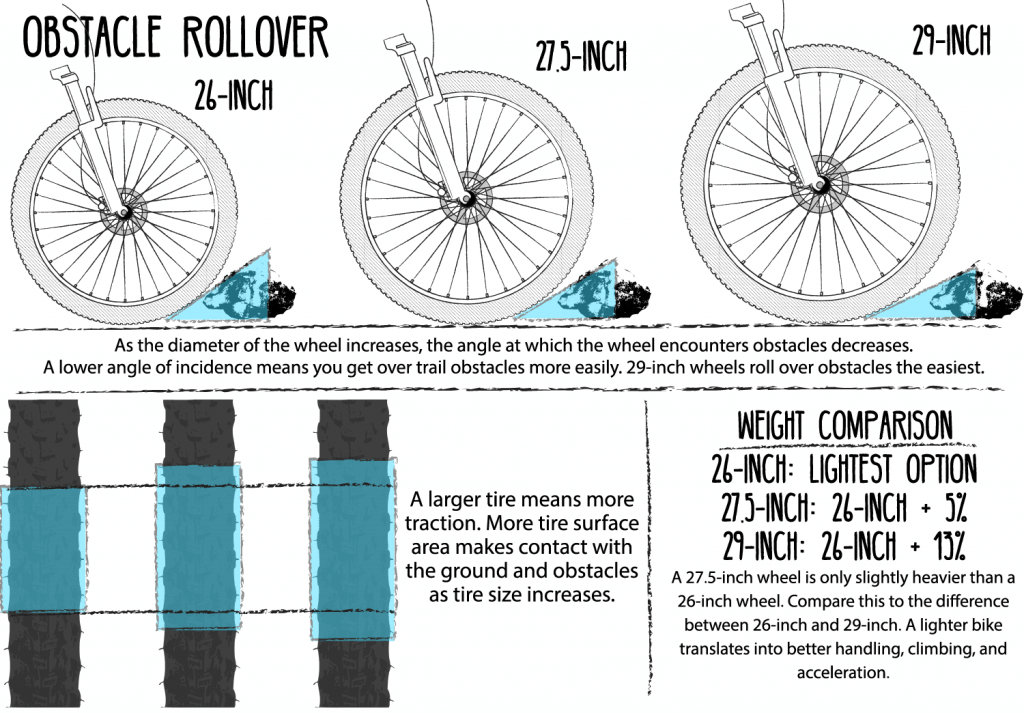
The size of your wheels also has a significant impact on how it performs.
Generally, there are 3 mountain bike wheel sizes today.
- 26″ wheels are the traditional size and are mainly reserved for dirt jump, freeride, and kids’ bikes. It offers the best maneuverability on the trail, allowing you to weave through technical singletrack. However, it will also have the most difficulty rolling over objects.
- 29″ (also known as 29er) wheels easily roll over logs and other obstacles, making it easier to maintain your speed on the trail. However, it is also more difficult to maneuver those larger wheels through corners.
- 27.5” (also known as 650b) wheels offer a happy medium between the two-wheel sizes. It should be noted that nowadays nearly all mountain bikes are built for either 27.5” or 29” wheels.
Tire width also plays an important role. A narrower tire, around 2.25”, will be lighter weight and have less surface area touching the ground, resulting in a faster roll. They’re commonly used in most hardtail mountain bikes from entry to top-level models.
Wider tires, 2.8”, will be slower, but will offer better traction and more puncture resistance. They are commonly seen in full-sus mountain bikes and e-mtb’s.
4. Tire Compound
The rubber compound used to make the tire will affect its traction, roll, and durability.
Harder rubber compounds have a fast roll and last longer while softer rubber compounds offer more traction but less durability.
Higher-end tires, such as the Maxxis Ardent, will actually mix different rubber compounds in a single tire, using harder compounds in the center for better roll resistance and durability while using softer compounds on the edges for better traction while cornering.
XC mountain bikes will typically use harder compounds for speed and durability while downhill bikes will use softer compounds for better traction and puncture resistance.
5. Tread Patterns

As if this hasn’t gotten complicated enough already, there are also tire tread patterns to consider. Each type of mountain bike riding puts different requirements on the tires.
The variety of tread patterns can be overwhelming; however, there are certain characteristics you can look for.
An XC tire like the Maxxis Ikon+ and Continental Trail King typically has smaller knobs and a tighter tread pattern which allows it to roll smoothly and hence lower rolling resistance and more speed.
On the other hand, a downhill tire like the Vittoria Martello has large knobs and wider spacing between them for more bite and traction. This would allow the tire to easily shed loose rocks and prevent mud from getting caked onto the thread.
6. Sidewall Puncture Protection

Puncture protection is a key part of mountain bike tires. As the tire rolls over a rough surface, the chances of cuts and punctures increase.
Hence, these tires usually come with a puncture protection layer that sits beneath the rubber compound. It is strong enough to resist the most minor cuts and avoid pinch flats.
7. Tubeless Ready
With recent enhancements in tire technology that have made tubeless tires much easier to install and maintain, tubeless are becoming more and more popular with mountain bike riders.
Why?
Tubeless offers a number of advantages that make them a very attractive option. First, when used with a tire sealant, tubeless tires are virtually impossible to flat.
And with no tube, there are no pinch flats. Secondly, tubeless tires can be run under less pressure, which means air pressure in the tires can be lowered to improve traction.
Read More : Should You Move to Tubeless Set Up?
FAQ
When Should I Replace My Mountain Bike Tires?
You should replace your mountain bike tires when there are signs of :
- More than 50% wear on the knobs as worn knobs will significantly affect your traction while taking corners.
- More than 75% wear on the center tread.
Also, note that the rear tires will wear out much quicker than the front tires as most of your body weight is on the rear.
What PSI Should Mountain Bike Tires Be Pumped to?
Mountain bike tire pressure usually ranges between 20 to 40psi.
There are many factors that affect tire pressure such as :
- Front vs Rear Tire. The rear tires will have a higher psi as the majority of your weight will be on the rear tires.
- Rider Weight. The lighter you’re, the lower the air pressure you can run.
- Tire Volume. The higher the tire volume (eg: 2.4″ wide and above), the lower the air pressure.
- Terrain. The harsher the terrain, the lower the air pressure.
Author Recommended Reads

